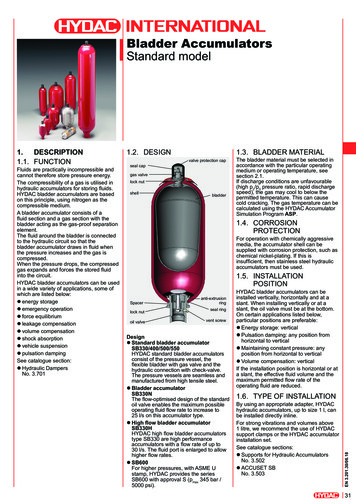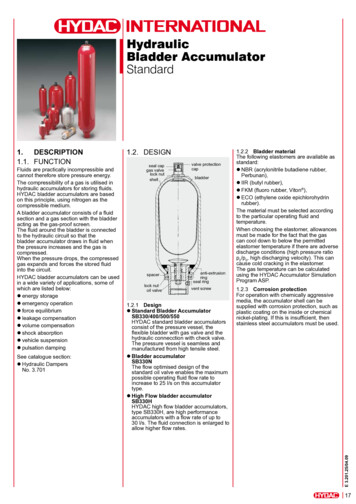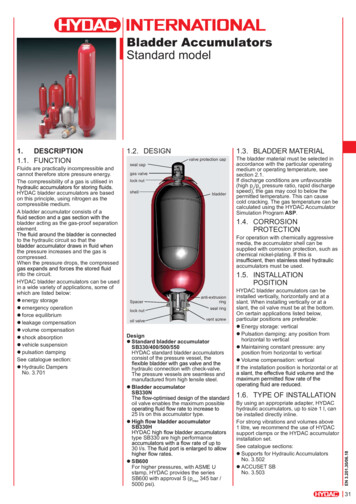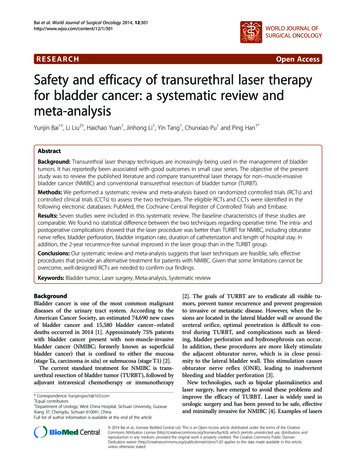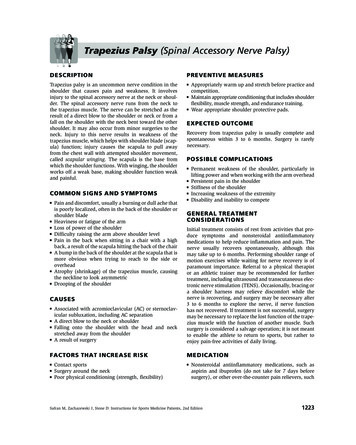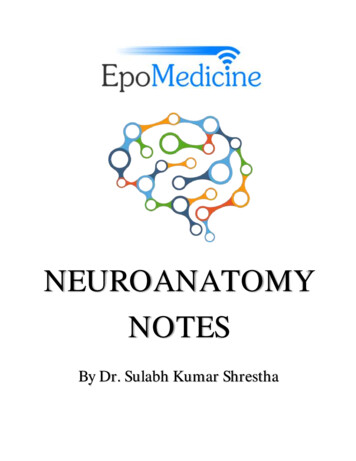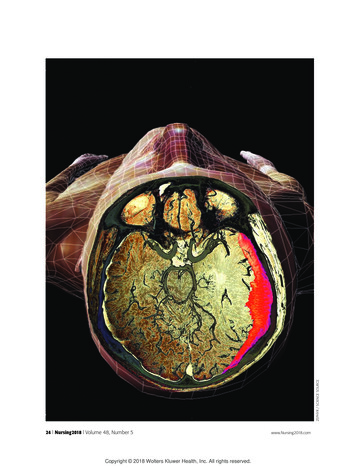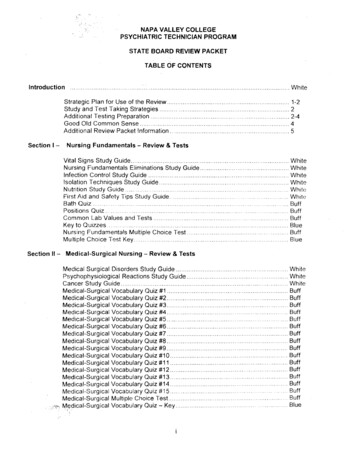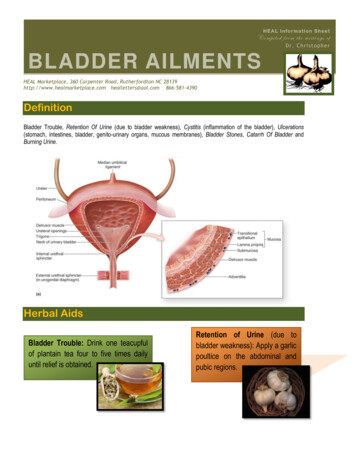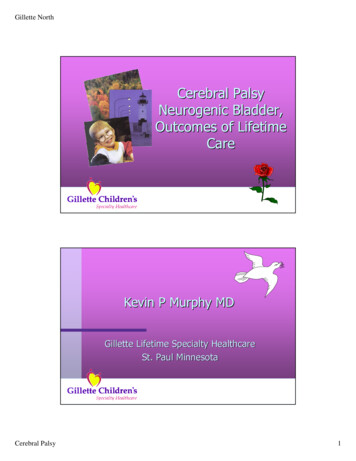
Transcription
Gillette NorthCerebral PalsyNeurogenic Bladder,Outcomes of LifetimeCareKevin P Murphy MDGillette Lifetime Specialty HealthcareSt. Paul MinnesotaCerebral Palsy1
Gillette NorthDisclosure InformationAACPDM 67’th Annual Meeting,October 16-19, 2013I have no financial relationships to discloseI will discuss the following off label use and/orinvestigational use in my presentation:Clostridium Botulinum Toxin A injections forurinary incontinence in adults with cerebral palsy.Cerebral Palsy2
Gillette NorthCerebral Palsy-Neurogenic Bladder1. McNeal DM, et al. DMCN 1983; 5: 612612-6.2. Dector RM, et al. J Urol 1987; 138: 11101110-2.3. Drigo P, et al. Ital J Neurol Sci 1988; 9:1519:151-4.4. Mayo ME. J Urol 1992; 147: 419419-20.4. Reid CJ, et al. Arch Dis Child 1993; 68: 739739-42.5. Houle AM, et al. J Urol 1998; 160: 10881088-91.6. Karaman M, et al. Int J Urol 2005; 12: 717717-20.7. Silva JA, et al. Urology 2010; 76: 942942-5.Cerebral Palsy-Neurogenic BladderBorzyskowski M. Cerebral Palsy and the Bladder.DMCN 1989; 31: 697697-9.Many factors involved with bladder control in peoplewith cerebral palsy.Factors include: age, cognition, communication,mobility, UE function, expectations, training,hypertonicity and compatible living environment.Continence more complicated than static CNSpathology & measured bladder function.Cerebral Palsy3
Gillette NorthCerebral Palsy-Neurogenic BladderMurphy KP, et al. Cerebral Palsy, Neurogenic Bladder &Outcomes of Lifetime Care. DMCN 2012; 54: 945945-50.214 people with CP seen in sequence through anoutpatient Rehabilitation Medicine clinic.96 females, 118 males. GMFCS levels I – V.52 with hemiplegia,hemiplegia, 42 diplegia,diplegia, 117 quadraplegia,quadraplegia, 3dyskinesia (athetosis component).Median age for total population 9.6 years (ages 55-66).Special education levels through graduate school.Cerebral Palsy-Neurogenic Bladder16.4% (35 individuals) with symptomatic neurogenicbladder (SNB) on urodynamic testing.91% obtained total continence or major improvement(drops in urinary pads only) with conservative care.Prevalence of males to females with SNB equal.SNB documented across the lifespan, educationalspectrum and functional levels.More common in those with bilateral involvement.Cerebral Palsy4
Gillette NorthCerebral Palsy-Neurogenic Bladder80% with spastic hyper-reflexic type onurodynamic testing (International ContinenceSociety Criteria 2010).Tendency for urinary retention and hypo-reflexiain the adult over 30 years old (GMFCS Level V).Upper urinary tract pathology infrequent.Small spastic bladder in child may overstretchinto larger hypo-reflexive bladder of adult.Cerebral Palsy-Neurogenic BladderMay be the most common missed diagnosis(associated condition) in the care of people with CP.One of the most easily treated problems inpeople with CP.A problem of Lifetime Care- more apparent in theadult but with often undiagnosed roots inchildhood.Cerebral Palsy5
Gillette NorthCerebral Palsy-Neurogenic BladderIndividual Selection CriteriaBasic and consistent yes/no communicationsystem in place.Personal desire to be dry, more continentand out of pads if possible.Functional Toileting Environment (FTE), ispresent or can be created.Functional Toileting Environment (FTE)An environment allowing toileting to occur ina continent & functional manner, includingnecessary communications, staffing,equipment and motivation.Can involve full medical and surgical teamreview including Occupational, Physical &Speech therapy, social services, psychologyand nursing support.Cerebral Palsy6
Gillette NorthFunctional Toileting Environment (FTE)Private environmentPublic environmentFriend’Friend’s homeFamily homeOutdoorsIndoorsUpstairsDownstairsFTE- Therapeutic InterventionsAugmentive communication device-Dynavox/IPADFloor Reaction AFO / L-CrutchesGrab bars/space to perform transfersITB/Botox/Phenol: eg hip adductorsAdaptive commode/time to sit alone in privacyStaffing assist and education that “can be done”.Cerebral Palsy7
Gillette NorthCerebral Palsy-Neurogenic BladderTreatment Options outside of FTEAnticholinergicsManagement of pelvic floor hypertonicityincluding hip adductors.Fluid schedulesCatheterization options (ICC, Indwelling)Surgical optionsCerebral Palsy-Neurogenic BladderDiagnostic TestingComputerized Functional Urodynamic StudyVoiding Cysto Urethrogram (VCUG)Renal Bladder Ultrasound (RBUS)Urine analysis &/or culturesMetabolic profile (electrolytes, BUN & creatinine)Vitamin B 12Cerebral Palsy8
Gillette NorthCerebral Palsy-Neurogenic BladderReasons for Failed TreatmentCognitive deficiencyBehavioral deficiencyMental Health diagnosesSexual abusePsychoPsycho-Social issues (eg(eg parents separated, livingin different homes with ongoing discord).Cerebral Palsy-Neurogenic BladderAdult who now becomes incontinentPrimary Condition (incontinence not in CP defintion)Secondary conditions (over stretched bladder nowwith retention & leaking; cervical spinal stenosis).Associated conditions (seizures, late onset dystonia).Comorbidities (stress incontinence; interstitialfibrosis; tumors; Alzheimer’s/CNS degeneration).Cerebral Palsy9
Gillette NorthCerebral Palsy-Neurogenic BladderContinence of urine; a part of basic human dignity.Should not be denied anyone within context ofpatientpatient-centered professional medical/surgical care.Further study & research in the urinary continence ofpeople with CP is hoped & called for at this time.Encouragement is given to facilitate Lifetime Caremedical & surgical practices for this problem ofyoung & old.Cerebral Palsy10
Gillette NorthCerebral Palsy11
Gillette North Cerebral Palsy 4 Cerebral Palsy-Neurogenic Bladder Murphy KP, et al. Cerebral Palsy, Neurogenic Bladder & Outcomes of Lifetime Care. DMCN 2012; 54: 945 -50. 214 people with CP seen in sequence through an outpatient Rehabilitation Medicine clinic. 96 females, 118 males. GMFCS levels I -V.
